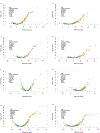Serum metabolites associate with lipid phenotypes among Bogalusa Heart Study participants
- PMID: 32131987
- PMCID: PMC7524581
- DOI: 10.1016/j.numecd.2020.01.004
Serum metabolites associate with lipid phenotypes among Bogalusa Heart Study participants
Abstract
Background and aims: Dyslipidemia has been identified as a major risk factor for cardiovascular disease. We aimed to identify metabolites and metabolite modules showing novel association with lipids among Bogalusa Heart Study (BHS) participants using untargeted metabolomics.
Methods and results: Untargeted ultrahigh performance liquid chromatography-tandem mass spectroscopy was used to quantify serum metabolites of 1 243 BHS participants (816 whites and 427 African-Americans). The association of single metabolites with lipids was assessed using multiple linear regression models to adjust for covariables. Weighted correlation network analysis was utilized to identify modules of co-abundant metabolites and examine their covariable adjusted correlations with lipids. All analyses were conducted according to race and using Bonferroni-corrected α-thresholds to determine statistical significance. Thirteen metabolites with known biochemical identities showing novel association achieved Bonferroni-significance, p < 1.04 × 10-5, and showed consistent effect directions in both whites and African-Americans. Twelve were from lipid sub-pathways including fatty acid metabolism (arachidonoylcholine, dihomo-linolenoyl-choline, docosahexaenoylcholine, linoleoylcholine, oleoylcholine, palmitoylcholine, and stearoylcholine), monohydroxy fatty acids (2-hydroxybehenate, 2-hydroxypalmitate, and 2-hydroxystearate), and lysoplasmalogens [1-(1-enyl-oleoyl)-GPE (P-18:1) and 1-(1-enyl-stearoyl)-GPE (P-18:0)]. The gamma-glutamylglutamine, peptide from the gamma-glutamyl amino acid sub-pathway, were also identified. In addition, four metabolite modules achieved Bonferroni-significance, p < 1.39 × 10-3, in both whites and African-Americans. These four modules were largely comprised of metabolites from lipid sub-pathways, with one module comprised of metabolites which were not identified in the single metabolite analyses.
Conclusion: The current study identified 13 metabolites and 4 metabolite modules showing novel association with lipids, providing new insights into the physiological mechanisms regulating lipid levels.
Keywords: High-density lipoprotein cholesterol; Lipids; Low-density lipoprotein cholesterol; Metabolomics; Total cholesterol; Triglyceride; Weighted correlation network analysis (WGCNA).
Copyright © 2020 The Italian Society of Diabetology, the Italian Society for the Study of Atherosclerosis, the Italian Society of Human Nutrition, and the Department of Clinical Medicine and Surgery, Federico II University. Published by Elsevier B.V. All rights reserved.
Conflict of interest statement
Declaration of Competing Interest J.K. is employed by Metabolon, Inc., and he contributed to the logistics and optimization of the untargeted metabolomics and the untargeted metabolomics data interpretation. Metabolon, Inc. was not involved in the design of the study, statistical analysis, or interpretation of the results. The other authors declared no conflict of interest.
Figures


Similar articles
-
An untargeted metabolomics study of blood pressure: findings from the Bogalusa Heart Study.J Hypertens. 2020 Jul;38(7):1302-1311. doi: 10.1097/HJH.0000000000002363. J Hypertens. 2020. PMID: 32004207 Free PMC article.
-
Novel serum metabolites associate with cognition phenotypes among Bogalusa Heart Study participants.Aging (Albany NY). 2019 Jul 21;11(14):5124-5139. doi: 10.18632/aging.102107. Aging (Albany NY). 2019. PMID: 31327759 Free PMC article.
-
Novel Metabolites Are Associated With Augmentation Index and Pulse Wave Velocity: Findings From the Bogalusa Heart Study.Am J Hypertens. 2019 May 9;32(6):547-556. doi: 10.1093/ajh/hpz046. Am J Hypertens. 2019. PMID: 30953049 Free PMC article.
-
Effect of coffee consumption on dyslipidemia: A meta-analysis of randomized controlled trials.Nutr Metab Cardiovasc Dis. 2020 Nov 27;30(12):2159-2170. doi: 10.1016/j.numecd.2020.08.017. Epub 2020 Aug 21. Nutr Metab Cardiovasc Dis. 2020. PMID: 33239163
-
Interethnic Differences in Serum Lipids and Implications for Cardiometabolic Disease Risk in African Ancestry Populations.Glob Heart. 2017 Jun;12(2):141-150. doi: 10.1016/j.gheart.2017.01.011. Epub 2017 May 17. Glob Heart. 2017. PMID: 28528248 Free PMC article. Review.
Cited by
-
Use of an Exposome Approach to Understand the Effects of Exposures From the Natural, Built, and Social Environments on Cardio-Vascular Disease Onset, Progression, and Outcomes.Front Public Health. 2020 Aug 12;8:379. doi: 10.3389/fpubh.2020.00379. eCollection 2020. Front Public Health. 2020. PMID: 32903514 Free PMC article. Review.
-
Macronutrient Proportions and Fat Type Impact Ketogenicity and Shape the Circulating Lipidome in Dogs.Metabolites. 2022 Jun 24;12(7):591. doi: 10.3390/metabo12070591. Metabolites. 2022. PMID: 35888715 Free PMC article.
-
Multicomponent Lipid Nanoparticles for RNA Transfection.Pharmaceutics. 2023 Apr 20;15(4):1289. doi: 10.3390/pharmaceutics15041289. Pharmaceutics. 2023. PMID: 37111773 Free PMC article.
-
Metabolomic Predictors of Non-alcoholic Steatohepatitis and Advanced Fibrosis in Children.Front Microbiol. 2021 Aug 12;12:713234. doi: 10.3389/fmicb.2021.713234. eCollection 2021. Front Microbiol. 2021. PMID: 34475864 Free PMC article.
-
Efficacy and compatibility mechanism of bear bile powder in Shexiang Tongxin dropping pills for acute myocardial infarction treatment.Chin Med. 2025 Jan 25;20(1):14. doi: 10.1186/s13020-025-01060-x. Chin Med. 2025. PMID: 39863867 Free PMC article.
References
-
- Farzadfar F, Finucane MM, Danaei G, Pelizzari PM, Cowan MJ, Paciorek CJ, et al. National, regional, and global trends in serum total cholesterol since 1980: systematic analysis of health examination surveys and epidemiological studies with 321 country-years and 3.0 million participants. Lancet. 2011;377:578–586. - PubMed
-
- Third report of the National Cholesterol Education Program (NCEP) expert panel on detection, evaluation, and treatment of high blood cholesterol in adults (Adult Treatment Panel III) final report. Circulation. 2002;106:3143–3421. - PubMed
Publication types
MeSH terms
Substances
Grants and funding
LinkOut - more resources
Full Text Sources

